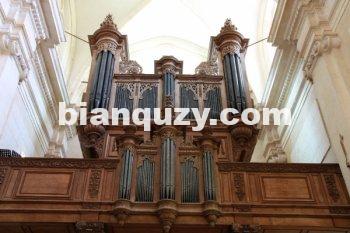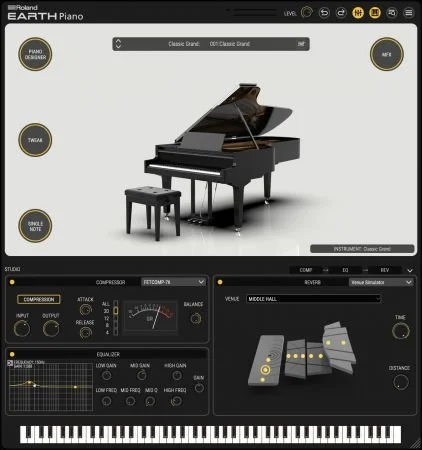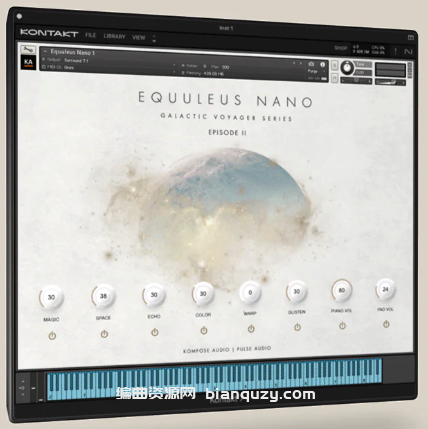前圣米歇尔修道院是法国北部中世纪的瑰宝之一。它始建于7世纪,最初在11 -13世纪繁荣,然后在17 -18世纪。在修道院的历史上,它曾被烧毁过几次,最后一次是在1971年。幸运的是,当时器官被拆除重建,所以它没有被破坏。它还躲过了历次火灾、法国大革命和第一次世界大战的破坏。
由于这几乎是奇迹般的历史,1714年让·博伊扎德建造的这把乐器被认为是保存不多的代表路易十四时代的乐器之一。它完美地表达了17世纪晚期法国风琴的语言,也就是所谓的大世纪末。这种类型的器官与18世纪启蒙时期的法国器官设计(如Dom Bedos, fr. Isnard等)在重要细节上有所不同。
七十年代,风琴在哈尔普夫和赫尔曼的作坊里被恢复到原来的状态;1983年9月24日,安德烈·Isoir主持了新修复的文书的就职仪式。停音的规格与1714年的乐器相同,音高也保留了下来(大约比现代音高低一个音调)。从1990年开始,管风琴工匠格奥尔格·威斯登菲尔德负责该仪器的维修工作。
该乐器是由大键盘基于一个8英尺的蒙特尔,和Positif基于一个4英尺的蒙特尔。第三本是独奏短号的Recit,第四本是Echo,包含了一个Echo短号停止。风琴共有四个操作手册和一个踏板,共有31个说话停顿。风琴以其异常美丽的笛子(在声音上几乎是“透明的水”),彩色的簧片和温暖的主旋律而闻名。
样品质量
样品提供24bit/48kHz质量;使用了多个版本(3个级别)和偶尔的多个攻击示例。Hauptwerk v。4和更高的支持(包括HW5)。混响时间约为4秒。环绕版本中提供了示例集。环绕版本可用于模拟湿样集以及(通过静压后方排名)。
示例集需要Hauptwerk版本4或更高版本。
指南针
手册的指南针是4个八度,没有最低的c#(这个音调实际上是在我们的模型中添加的)。踏板指南针是2个八度,没有最低的c#(实际上也增加了)。在虚拟器官模型中提供了手动和脚踏指南针的扩展。
调音与音律
风琴被调成一种相当苛刻的单音律,它的音调比现代的音调要低一些。当记录时,它的heigth大约是a=392 Hz。虽然Hauptwerk有“原始风琴调音”,但它不能与手册的扩展罗盘和踏板一起工作。相反,可以考虑使用专用的St. Michel temperament chart,它将与样本集一起安装。这个禀性图表也体现了乐器的原始调音,同时完美地重新抛出了延长的键。
内存消耗
完整的样品集装载在环绕环境中,24位质量:11.9 GB
完整的样本集以16位的质量加载:6.5 GB
仅限16位的wet选项:3.5 GB
The former Benedictine monastery of St. Michel en Thierache is one of the mediaeval gems of Northern France. Founded in 7th century, it flourished first during the 11th-13th, and then in the 17th-18th, centuries. During its history, the abbey was damaged several times by fire, the last time in 1971. Fortunately, the organ was dismantled for reconstruction at that time, so it escaped destruction. It also escaped damage during previous fires, the French revolution, and the First World War.
Because of this almost miraculous history, the instrument built by Jean Boizard in 1714 is believed to be one of the rarely preserved instruments representative of the era of Louis XIV. It perfectly expresses the language of the French organ of the late 17th century, of the so called Grand Siecle period. This type of organ is different in important details from the design of the French organ during the Enlightment of 18th century (e.g. Dom Bédos, fr. Isnard etc.).
The organ was restored to its original state during the seventies in the workshop of Haerpfer and Hermann; the inauguration of the newly restored instrument took place on 24th September 1983 by André Isoir. The specification of the stops is identical to the 1714 instrument and also the pitch was retained (about one tone below the modern pitch). Since 1990, the organbuilder Georg Westenfelder is responsible for the maintenance of the instrument.
The instrument is composed of the Grand Clavier based on an 8-foot Montre, and the Positif based on a 4-foot Montre. The third manual is the Recit with a solo cornet, and the fourth manual is the Echo, which contains an echo cornet stop. In total, the organ has four manuals and a pedal with a total of 31 speaking stops. The organ is known for its exceptionally beautiful flutes (in sound almost “water transparent”), colorful reeds, and warm principals.
Sample Quality
The samples are offered in 24bit/48kHz quality; multiple releases (3 levels) and occasional multiple attack samples are used. Hauptwerk v.4 and higher supported (incl. HW5). The reverberation time is about 4 seconds. The sample set is presented in the surround version. The surround version can be used for emulating the wet sample set as well (by muting the rear ranks).
The sample set requires Hauptwerk version 4 and above.
The Compass
The compass of the manuals is 4 octaves without the lowest C# (this tone was added virtually in our model). The pedal compass is 2 octaves without the lowest C# (also added virtually). The extension of manuals and pedal compass is offered in the virtual organ model.
The Tuning and Temperament
The organ is tempered to a rather harsh meantone temperament and it is pitched about a tone lower than the modern pitch. When recorded, its heigth was about a=392 Hz. Althought the “Original Organ Tuning” is availabe in Hauptwerk, it will not work with the extended compass of the manuals and the pedal. Instead, consider using the dedicated St. Michel temperament chart which will be installed together with the sample set. This temperament chart also features the original tuning of the instrument, while repitching the extended keys perfectly.
RAM consumption
The full sample set loaded in surround, in 24-bit quality: 11.9 GB
The full sample set loaded in 16-bit quality: 6.5 GB
The wet only option in 16-bit: 3.5 GB







